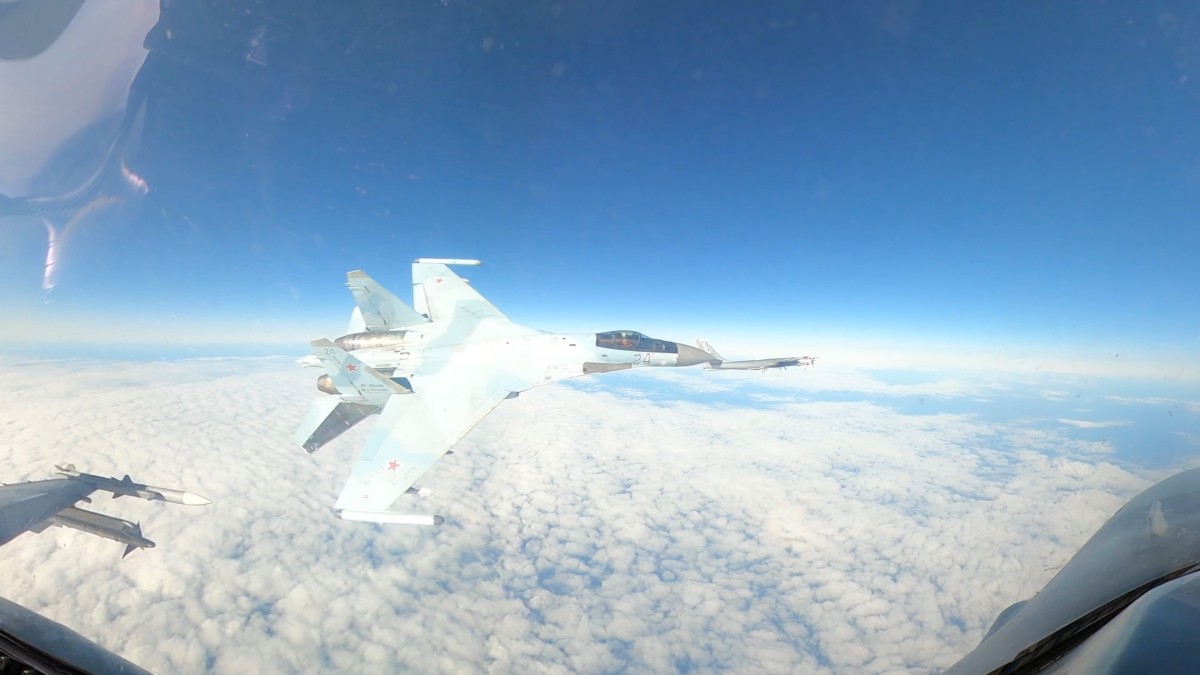In a tense encounter near Alaska, a Russian Su-35 fighter jet flew dangerously close to a US F-16 fighter on September 23, 2024, conducting an “unsafe” maneuver referred to as “headbutting,” according to the US military.
The North American Aerospace Defense Command (NORAD) released footage of the incident, which took place in the Alaska Air Defense Identification Zone (ADIZ).
The intercept occurred during routine operations by the US F-16, assigned to NORAD, which monitors airspace around North America.
The ADIZ is a buffer zone beyond US sovereign airspace where foreign aircraft are required to identify themselves, and intercepts by US fighters are a regular occurrence, particularly with Russian aircraft.
However, while most intercepts are handled professionally, this recent encounter was different due to the reckless action of a Russian Su-35 fighter aircraft.
https://twitter.com/NORADCommand/status/1840776113846468898
Video evidence shows the US F-16, which was intercepting a Russian Tu-95 bomber, suddenly encountering a Su-35 fighter jet.
The Russian aircraft cut dangerously across the nose of the F-16 in a maneuver known as “headbutting,” endangering both aircraft. In footage captured from the cockpit of the US fighter, the pilot can be heard reacting in surprise as the Russian Su-35 Flanker quickly passed by.
The US jet was equipped with AIM-9 Sidewinder and AIM-120 AMRAAM air-to-air missiles, underscoring the potential danger of the incident.
The F-16 is believed to be part of the 18th Fighter Interceptor Squadron, based at Eielson Air Force Base in Alaska. This squadron routinely responds to foreign aircraft in the region.
NORAD commander Air Force General Gregory Guillot condemned the Russian pilot’s action, stating, “The conduct of one Russian Su-35 was unsafe, unprofessional, and endangered all – not what you’d see in a professional air force.”
According to NORAD’s original report from September 23, four Russian aircraft, including the Tu-95 and Su-35, were operating in the ADIZ.
While the Russian aircraft remained in international airspace and did not enter US or Canadian territory, such encounters highlight the ongoing tensions in the region.
“NORAD employs a layered defense network of satellites, ground-based and airborne radars, and fighter aircraft to track aircraft and inform appropriate actions. NORAD remains ready to employ a number of response options in defense of North America,” NORAD noted at the time.

Spike In Russian Military Activity Near Alaska
In recent months, Russia’s military activities in the vicinity of Alaska have surged, paralleling similar actions by China as both nations extend their power-projection capabilities in the air and at sea.
Alaska has become a significant area of interest for these two powers, prompting heightened attention from the United States.
A notable event occurred in July when Russian and Chinese bombers conducted joint flights in international airspace off the coast of Alaska for the first time.
This unprecedented collaboration raised alarms for US officials, including Defense Secretary Lloyd Austin, who expressed concerns about the implications of such cooperation.
In response to these developments, the US Department of Defense has decided to strengthen its presence in this strategically crucial region.

Increased resources have been allocated, including the deployment of naval assets to monitor and deter any rising Russian and Chinese air and naval operations that have become more frequent recently, as reported by the EurAsian Times.
Alaska’s Senator Dan Sullivan weighed in on the situation, stating that incidents like the joint military drills conducted by Russia and China near U.S. waters highlight the vital significance of the Arctic in the power struggle between the U.S., Russia, and China.
He characterized the recent “headbutting” maneuver conducted by the Russian Su-35 as “reckless and unprofessional.”
While such maneuvers are seen as unprofessional when executed at dangerously close ranges, they have a long history, particularly during the Cold War.
Recently, however, they have gained new significance amid escalating tensions resulting from the war in Ukraine, where the US and its allies find themselves in direct opposition to Russia.
China, too, has been known to engage in similar provocative actions, including deploying radar-reflecting chaff in the path of targeted aircraft, raising significant safety concerns.
The US Air Force also utilizes the “headbutt” maneuver to gain attention from wayward aircraft, typically in a less aggressive manner.
According to NORAD, civil air patrols might use this tactic when a pilot fails to respond to radio communications. By flying through an aircraft’s flight path, pilots create a noticeable visual cue and turbulence designed to attract the attention of the other pilot, albeit from a safe distance.
- Contact the author at ashishmichel(at)gmail.com
- Follow EurAsian Times on Google News




